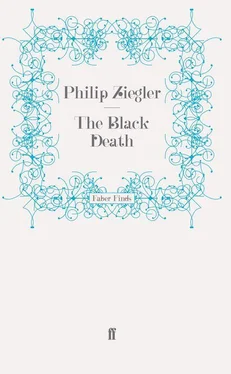* * *
On 28 July 1348, Archbishop Zouche of York had taken alarm at the news from the Continent and sent out a warning order to his flock:
‘In so far as the life of men upon earth is warfare,’ he wrote,
it is no wonder that those who battle amidst the wickedness of the world are sometimes disturbed by uncertain events; on one occasion favourable, on another adverse. For almighty God sometimes allows those whom he loves to be chastened so that their strength can be made complete by the outpouring of spiritual grace in their time of infirmity. Everybody knows, since the news is now widely spread, what great pestilence, mortality and infection of the air there are in divers parts of the world and which, at this moment, are threatening in particular the land of England. This, surely, must be caused by the sins of men who, made complacent by their prosperity, forget the bounty of the most high Giver. {359}
The Archbishop prescribed the usual course of prayer, processions and litanies to avert the coming of the dreadful pestilence.
When the Archbishop thus addressed his flock, the Black Death had hardly arrived in England. Nearly ten months were to elapse before the first cases were recorded in Yorkshire. For the Englishmen in the south, who had heard with alarm of the terrible plague in Europe, the situation had seemed perilous enough. But France was another country, the Channel lay between; ‘it can’t happen here’ was then, as always, the reaction of the Englishman confronted by disorder among the lesser breeds without the law. But such comfort could not last long. From the moment that the plague got a firm grip in Dorset it must have been clear to every well informed Englishman that, in the end, his turn would come. The more pious or the more optimistic no doubt continued to hope that some miracle would avert their doom but, as the plague moved inexorably northwards, even the most confident must have lost their faith.
Though he may have discounted some of the wilder rumours, any northerner who kept his ears open in the spring of 1349 must have been led to believe that, in all probability, he had no more than a fifty-fifty chance of surviving the rest of the year. His family and friends could be expected to die around him and those in authority over him were more than likely to join him in the churchyard. Life, as he knew it, seemed on the verge of breaking down. Faced with such a threat the temptation must have been great to eat, drink, be merry and do little else besides. It is notable that, whether through apathy, self-discipline or the resignation that comes from perfect faith, there seems to have been no such reaction. Until the moment that the plague reached his village – with a minor exception in Durham which we shall mention shortly – even, indeed, when it was already rampant, the average northerner continued to till his fields, tend his cattle and perform his manorial duties. The threat of infection was not enough; only death, it seemed, could distract him from his daily duties.
Though the mortality in Yorkshire was not quite so wholesale as in other counties, certainly much less so than in neighbouring Lincolnshire, the Black Death was far from merciful. In the 535 parishes of the diocese of York, of which the great majority were in Yorkshire itself, 223 benefices were vacated by death, sixty-three by resignation and a further fourteen from unspecified causes. Between 42 per cent and 45 per cent of the parish clergy died.
The huge archdeaconry of York shows the usual wide variants in the mortality rate from area to area. The deanery of Doncaster lost nearly 59 per cent of its clergy, yet virtually no benefices were vacated in the marshes between Doncaster and the Humber. In Pontefract the figure was 40 per cent, again with few or no casualties in the eastern flats. And yet in the mountainous district of Craven which, on the analogy of Derbyshire, should have suffered severely, a mere 27 per cent perished. York itself, with 32 per cent, was relatively lightly touched.
In so vast a county it will be obvious that the Black Death could not have arrived everywhere at the same time. It is most unlikely that more than a handful of cases occurred before April 1349; Pope Clement VI’s Bull of 23 March from Avignon referred to the plague as having already begun to harass the diocese but it seems certain that this was premature and that, even if there had been an outbreak in March or early April, it was confined to Nottinghamshire or perhaps to one or two coastal areas. It did not arrive in the city of York until 21 May. June, July and August were the worst months all over the north of England.
The Archbishop of York held to his normal practice and discreetly sat out the summer months at one or other of his rural manors near the little town of Ripon. {360} His suffragan, however, Archbishop Hugh of Damascus, behaved with a vigour unusual in a senior churchman. He was an Austin friar who had once been excommunicated by Archbishop Grandisson for outrageous behaviour. {361} This unconventional background perhaps explained why he so far forgot his rank as to tour his diocese, visit the sick, encourage the healthy and consecrate many new churchyards. These were usually only authorized for temporary use and the citizens of Fulford, a mile or so south of York, found themselves in trouble some years later when they persisted in burying their dead in their new churchyard of St Oswald long after the Black Death had passed. Archbishop Thoresby, in a curious commentary on the pleasures of the times, accused them of ‘taking an empty delight in novelty’ and ordered them to resort forthwith to their traditional burial ground. {362}
York was one of the largest cities in England; smaller only than London and, perhaps, Norwich. Professor Russell {363} estimates the population in 1377 at 10,872. By that date economic expansion had already been resumed and the plague, destructive though it was, provided no more than a check in a process which lasted till the end of the century. {364} But, at the time of the Black Death, the city was already in difficulties, since a disastrous flood had submerged its western parishes on 31 December 1348. {365} Jeanselme, who contends that floods, famines and earthquakes invariably precede an epidemic of plague, indeed cites the flooding of the Ouse as evidence of his thesis. {366} It is hard to see why, in that case, the plague should have spread with equal vigour to all the other cities where the Ouse did not overflow and no earthquake or famine took place. But one can accept that the commotion which the sudden flood must have caused among the rats of York could have helped the spread of infection throughout the city and the neighbourhood.
At the Abbey of Meaux, six miles north of Hull, the monks were already expecting the worst. On the Friday before Passion Sunday, they recalled, they had been violently thrown from their stalls by an earthquake. Such a portent could only have meant trouble to come. When it was coupled with the undoubtedly sinister birth of Siamese twins in Kingston-upon-Hull and their death a few days before, then even the most sceptical could hardly have doubted the imminence of disaster. Disaster duly came. ‘…God’s providence ordained at that time’, wrote the chronicler of the monastery, ‘that in many places the chaplains were kept alive to the very end of the pestilence in order to bury the dead; but after this burial of the lay folk the chaplains themselves were devoured by the plague, as the others had been before them.’ {367} The Abbot, Hugh de Leven, and five monks died in a single day, on 12 August 1349; the prior, the cellarer, the bursar and seventeen other monks died also and, out of fifty monks and lay brethren, the chronicler claims that only ten survived. {368} The Abbey found its revenues so reduced that it was forced to lease its grange for life to a certain Sir William de Swine for a lump payment of £ 80. Whether by divine intervention, coincidence or monkish initiative, Sir William was murdered shortly afterwards and the grange reverted to the Abbey. But, in spite of this windfall, recovery was slow and, in 1354, the Abbey was handed over to a royal commission ‘on account of its miserable condition’. {369}
Читать дальше












